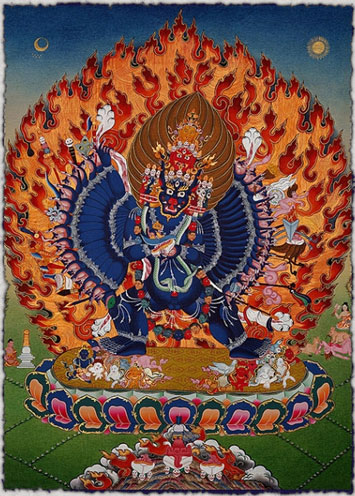
Yamāntaka — Destroyer of Death
For more information about the tantric path, google ‘vajrayana.’
More than any other form of Buddhism, the Tibetan tradition employs tantric symbolism and ritual, featuring a vast array of mysterious deities and arcane practices that make it look like the Catholic church of Buddhism—and more. Also known as the vajrayana (way of the thunderbolt/diamond) or mantrayana (way of mantra), the tantric path is populated by figures ranging from the beatific to the awful, all either enlightened buddhas or powerful, other-worldly creatures subdued into the service of the Buddhadharma. For example, Mahakala is a ferocious alter ego of Chenrezig, the Buddha of compassion.
The many forms correspond to the many needs of tantric practitioners. The image on the right is of Yamantaka, the wrathful form of Manjushri, who represents all the Buddhas’ wisdom. Yamantaka means ‘destroyer of death,’ and is also known in Sanskrit as Vajra Bhairava, or the ‘Adamantine Terrifier.’ This tantric deity is particularly popular in the largest school of Tibetan Buddhism, the Gelugpas — a scholastic system that awards the ‘geshé’ degree to those who undergo years of memorization, debate and public examination.
A thorough grounding in the ‘ordinary’ practices of Buddhism is considered an essential prerequisite for the effective practice of tantra—which, by contrast, is the accellerated, ‘extraordinary’ path. It is considered dangerous, and comes with a strict code of secrecy enforced by the threat of inconceivably long sojourns in special ‘vajra hells’ for transgressors. Some say that even though many of these figures and their deity-yoga practices are widely available, effective secrecy is guaranteed by the great difficulty of the practice and the impossibility of real progress without genuine grounding and authentic empowerment.
All four classes of Tantra are based on taking the goal as the path; i.e., visualizing oneself as a fully enlightened being and imagining the surrounding world and its inhabitants as projections of the awakened mind. The highest forms of tantra employ the imagery of lust and fury and aim to transmute the energy of negative emotions into pathways of virtue.
Not unexpectedly, some people prefer to hurry through the ordinary practices and ‘progress’ to tantric ritual as soon as possible. Tantra, after all, is much more ‘interesting’ than the basic practices of the eightfold path and the monotony of calm-abiding (shamatha) and insight (vipassana) meditations. When used inappropriately, tantric visualizations beguile the restless mind with exciting imagery, some of it sexual. Despite clear warnings of the necessary prerequisites and the importance of secrecy, its open dissemination is not as widely discouraged by Tibetan lamas as one might expect. They often rationalize that attendance at a tantric empowerment ceremony—and attempts to master the complex visualizations—will at least leave a karmic imprint in the mindstream, to ripen to good effect at a later date or in a future lifetime.

Vajra Bhairava
With a buffalo head and eight other faces drooling blood,
thirty-four arms clasping weapons and sixteen legs trampling enemies,
The Destroyer has a necklace of fifty moist human heads, flaming hair and an erect penis
Another appealing aspect of tantra is the comfort of belonging to a secret brotherhood. On the one hand, it reveals inner weakness (in order to relinquish ego, one must first cultivate robust self-esteem); on the other, it exploits the very clinging to illusions of security that maintains cyclic existence. However, considerations like this are often overturned by the bizarro-logic of tantra in which the negative becomes positive and the weak becomes strong. For example, women (Tib: skyes dman, or ‘lesser born’), are generally considered in Tibetan Buddhism to be spiritually weaker, but can turn this to their advantage by investing their innate weakness in the service of tantric practice.
Author’s note: I feel amply qualified to comment on the inappropriate adoption of tantric practice as I was guilty of it myself. Impatient of the ordinary practices, and eager to achieve the bliss of enlightenment, I entered into tantric empowerments by conveniently putting aside the established caveats and unflattering reality of my own mental instability and pretended myself a suitable receptacle. I have no tantric ‘experience’ and do not teach either tantric methods or even tantric ‘philosophy.’ The things of which I speak here are mere words derived from my former teachers and their scriptures. They are meant as a reminder to focus on the basic practices of mindful reflection.
